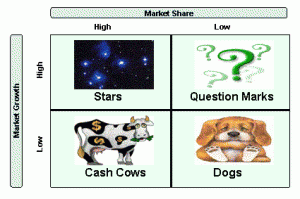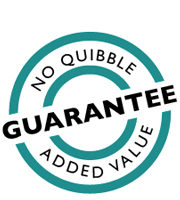Boston matrix
 The Boston Consulting Group (BCG) pioneered portfolio management with its growth share matrix known as the Boston matrix.
The Boston Consulting Group (BCG) pioneered portfolio management with its growth share matrix known as the Boston matrix.
The key to understanding and applying the Boston matrix are BCG’s assumptions that:
- Higher market shares are directly related to higher levels of profitability and cash generation due to efficiency economics of scale
- Faster growing markets are more economically attractive than slower growing or declining markets
 The Boston matrix categories a business’s activities into four segments. These are:
The Boston matrix categories a business’s activities into four segments. These are:
- High market share and high market growth known as ‘Stars’. Stars are what every company desires, as when well managed, they effectively give a company a license to print money.
- High market share and low market growth known as ‘Cash Cows’. Cash Cows often constitute the centre of gravity of a company’s activities and are usually responsible for generating most of a company’s near term cash. However, unless they are re-invigorated, the cream from Cash Cows will thin and turn to milk before eventually running out. The decisions relating to Cash Cows are:
- Where best to invest the cash they generate i.e. whether to invest in Stars, Question Marks or new business opportunities
- How to sustain and extend the flow of cash from Cash Cows for as long as possible
- Low market share and high growth known as ‘Question Marks’ or ‘Problem Children’. With Question Marks, the decision is whether to invest in order to grow market share in an attempt to become a Star, or whether to ease off and decay into a ‘Dog’.
- Low market share and low market growth known as ‘Dogs’. Every business has a few Dogs, but nobody wants a full kennel. Dogs often create complexity and distract time and effort from a company’s core activities. In such circumstances, the question to consider is whether there is more value in disposal than retention and managed death. And what constitutes a Dog for one business can sometimes constitute a Star for another, especially if the acquiring business is able to apply focused skilled management attention.
The great beauty of the Boston matrix is that it is an easy tool to use and provides powerful insights into how a company can best to manage its portfolio. The tool can also be used for various different slices and dices of a business or any combination of them.
The key issues and limitations of the Boston matrix are:
- Growth is only one of the factors that defines the economic attractiveness of a market.
- Market share is only one factors that defines a company’s ability to compete and generate cash from a particular market.
This led McKinsey & Co to build on BCG’s pioneering work and develop its own portfolio management matrix, known as the McKinsey matrix.
To discuss your business critical issue
Please call Paul New on 020 8390 9972 or 07790 501225 or send a message.







